|
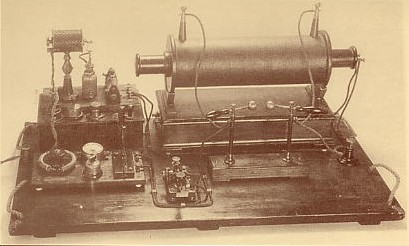 |

|
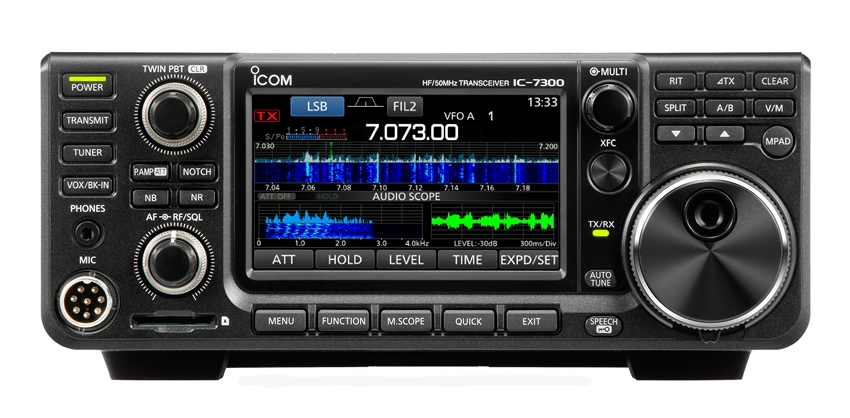 |
|
Guglielmo Marconi
Callsigns: MAA-MZZ
Experimental Radio
Communications
From 1895-1937 |
 |
Philip L
Callsign: G0ISW
(Ex G1MOG / BRS 85124)
Amateur Radio
Communications Since 1985
(SWL 1983) |
|
|
|
|


If you cannot see the full
index shown on the left edge of your screen, please go to my main page at
http://www.qsl.net/g0isw
HF (High Frequency) radio signals in the
range of 1.8MHz - 30MHz enable
Amateur
Radio transmissions to travel World-wide, provided that the right conditions
exist to reflect the signal sent from the transmitting station (from a layer of
the Earth's atmosphere called the Ionosphere)
back to the Earth's surface and back again, perhaps several times before
it reaches the Receiving station which could be many thousands of miles
(km) away on the other side
of the World. To see what HF propagation could be like now for your location,
please try either the
VOACAP online HF
propagation prediction tool or the
VOACAP online HF coverage
maps.
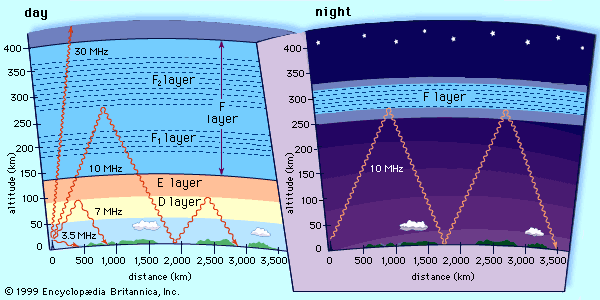
Ionization levels vary
greatly between Day (Left) and Night (Right) causing HF radio waves to reflect
off different layers of the Ionosphere
or travel straight through them depending upon frequency and angle of
transmission. Under certain conditions multiple reflections can occur between
the Ionosphere
and the ground or Sea to enable Worldwide communications.
The
Ionosphere
and therefore also the
Maximum Useable
Frequency (MUF) for HF Radio Communication is greatly affected by the Sun's
on average 11 year Solar
Cycle. In 2008 the Solar
Cycle was thought to be at minimum, with HF radio communications much
degraded from Solar Maximum, forecast to occur next in around 2013/14.
HF real-time Propagation
Map by NG0E
(Click on historical image below for current map)
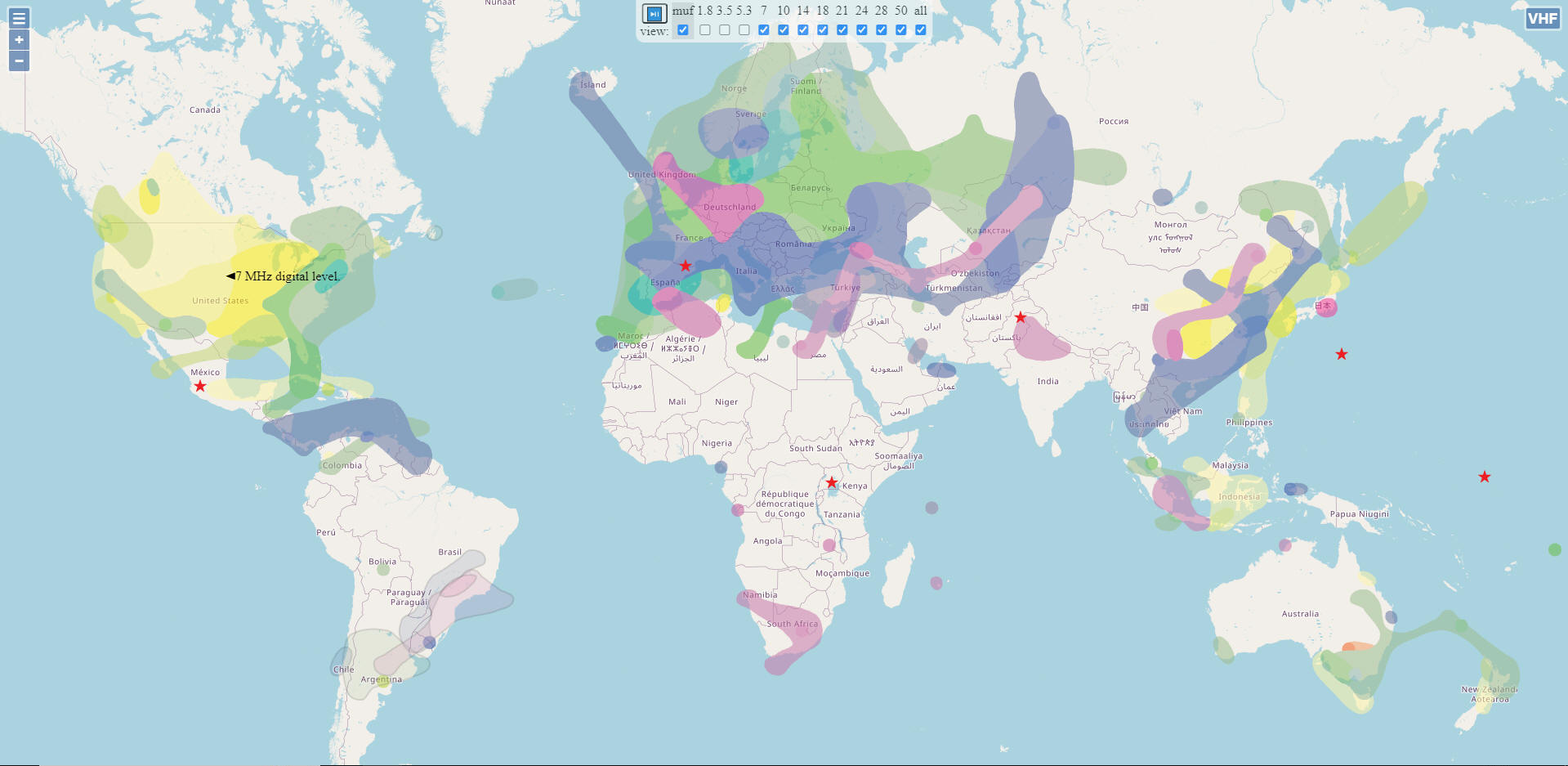
If
you already use your computer soundcard for data modes such as PSK31, then you
may like to try the new
WSPR (Distant Whispers) software
by K1JT, which transforms your station into an automated beacon and weak signal
reception hub. You will be amazed how far your low power signals can be heard
and can see maps in real time. Great for antenna experimentation too. There is
even a searchable WSPR spots database
Below is a map showing my 5W
10MHz WSPR
signals reaching
VK1UN in Australia using a small HF vertical on
8th April 2011.
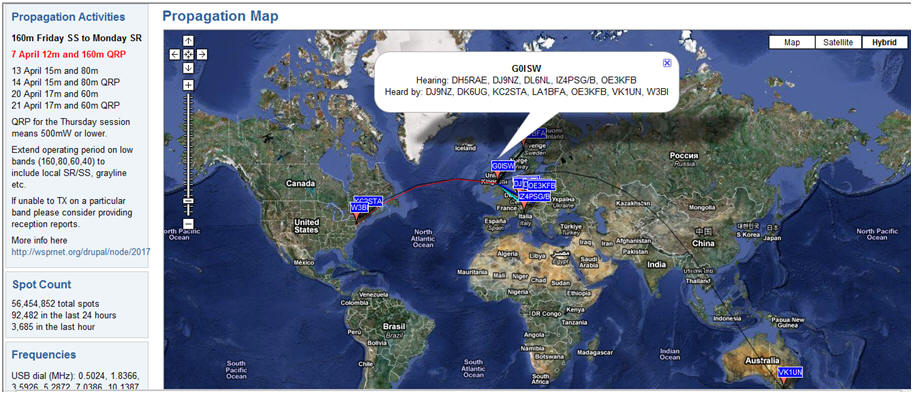
The WSPRnet database shows my
10.140195 MHz signal
to VK1UN in Australia had a SNR of
-28 dB and the distance was my best yet at
16947 km.
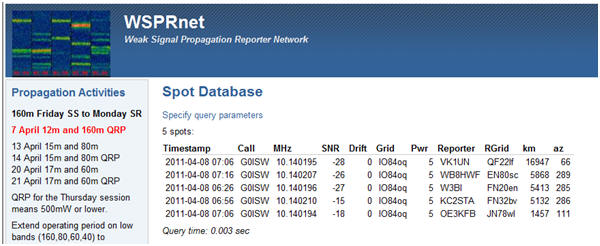
Near Vertical Incidence
Skywave (NVIS) is a radio wave propagation method that provides
usable signals in the range between
Groundwave
and
Skywave distances (usually 30 to 400 miles, or 50 to 650 km). It is
used mainly for military communications and by radio amateurs. The
transmission frequency is selected close to, but not over, the critical
frequency (the highest frequency which the F layer will reflect at a
maximum--90 degree--angle of incidence)
travel at very high angles approaching 90
degrees upwards into the
ionosphere, where they are
refracted back down and can be received within all distances from 0
km to 650 km from the transmitter. If the frequency is too high,
refraction fails to occur and if it is too low absorption reduces the
signal strength.
Click on the
following link, or the thumbnail below, to view the latest
NVIS foF2 Ionospheric Map. This
displays the highest Critical frequency for NVIS Communications and in
the example shown below for stations based in the UK 4 MHz is the maximum
as indicated by the dark green colour, so
radio amateurs would use the 80m
(3.5-3.8 MHz) band for the time and date shown for NVIS Regional UK HF
Communications. As of 2015 the Europe only version appears to be
discontinued and I can now only find a World map.
|
Click on image below for latest live Critical frequency map |
|
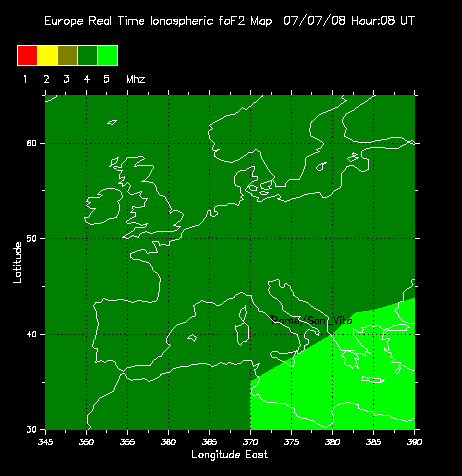 |
The usable
frequencies for NVIS
communications are between 1.8 MHz and
10 MHz. The most common bands
used in amateur radio are 3.5 MHz and
7 MHz, with experimental use of
5
MHz (60
meters) frequencies. Military NVIS communications mostly take place
on 2-4 MHz at night and on
5-7 MHz during daylight. The lowest layer of
the ionosphere, called the
D layer, causes attenuation of low frequencies during the day. This
layer disappears at night enabling improved communications at the lower
frequencies during the night.
An
NVIS antenna configuration
is a horizontally polarized (parallel with the surface of the earth)
antenna placed low to the ground to ensure a high angle of takeoff,
Vertically polarised antennas are not suitable for NVIS as they produce
low angles of radiated signals and therefore the skip distance will be
too great for local HF communications.
My own NVIS
antenna is a military tactical dipole at only 2m height above ground
level (AGL), with this antenna on 5 MHz I
can work throughout the UK during daylight hours from the Shetland Isles
to London and everything in between.
The conditions
that affect HF signals are in the main determined by the current Solar
Cycle, which peaks every 11 years on average, unfortunately in 2010 we were
just coming out of the Solar
minimum, which means that conditions were poor and many of the
higher frequencies above 14 MHz could not be reliably used.
Whether the path is in daylight
or darkness also affects which layers of the Ionosphere
will reflect HF signals and at what frequency. Amateur
Radio FAQ.
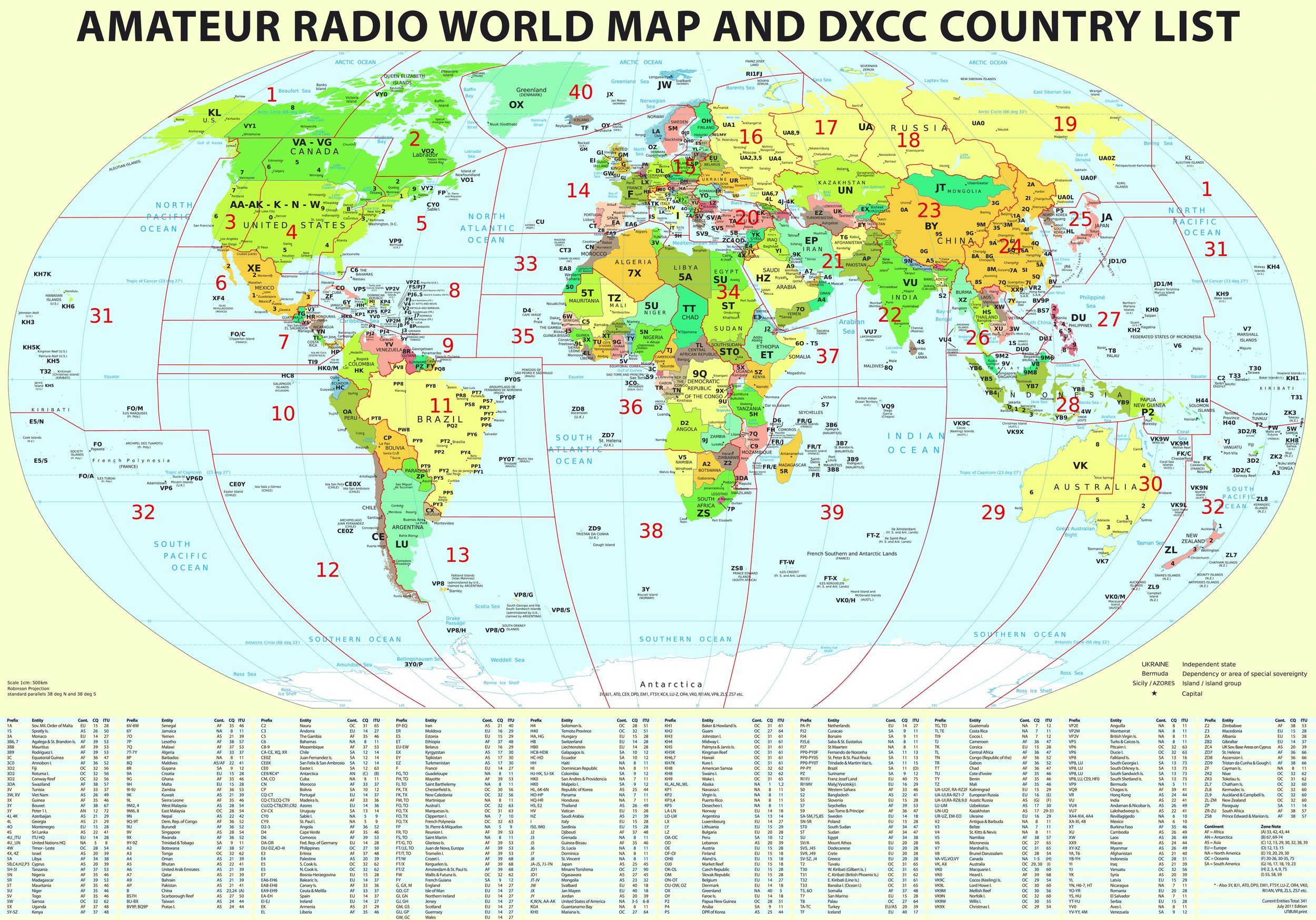


UK HF Band Plans
160m band (1.8 MHz)
Not much shorter than medium waves, at
daytime the "Top Band" is deeply affected by D-layer absorption and
only radio waves entering the ionosphere at a very high angle can be
reflected to the ground. At daytime this band is thus mainly dedicated
to local QSOs by ground waves, up to distances reaching about 120 km.
It is thus relatively quiet compared to the other HF bands. At night
the D-layer disappears, allowing low-angle signals to reflect more
easily on via the F-layer, and DX contacts are possible at several
thousands of kilometres. This is a band to mainly use at night.

80m band (3.5 MHz)
This band is similar to 160m but as
the frequency increases the D-layer absorption begins to decrease as it is
proportional to the inverse square of the frequency. At daytime most contacts
are worked with near countries, up to about 2000 km from your QTH. At night or
using the gray line it is possible to exceed 9000 km (e.g. Europe to W, UA or JA).
If you wake up in winter a few hours before the sunrise to avoid atmospheric
noises you can work most DX stations (e.g. VK, ZL from Europe). In Region 1 the
frequencies ranging between 3775-3800 kHz are usually dedicated to DX hunters.
|
3.5
MHz (80 metres) 3.500-3.800 MHz
|
|
Band plans
UK by RSGB |
3.5MHz
spots Cluster |
80m
antennas
|
EMPTY
|
|
EMPTY
|
EMPTY
|
 80m
ARDF 80m
ARDF
|
 160m/80m
coaxial receiving loops 160m/80m
coaxial receiving loops
|
|
Frequency |
Mode
|
Remarks
|
|
3.500-3.570 MHz |
CW
|
Morse Code
|
|
3.570-3.580 MHz |
USB (Narrow band data modes)
|
New 200 Hz narrow band mode segment, from
June 2016 |
|
3.576-3.580 MHz |
USB (JT65/JT9)
|
JT65/JT9 Data
mode Activity
|
|
3.580 MHz |
USB (PSK31)
|
PSK31 Activity
|
|
3.580-3.590 MHz |
USB (Narrow band data modes)
|
Narrow band data modes 500 Hz |
|
3.590-3.600 MHz |
USB (AX25 Packet)
|
Packet
Radio
or unattended data modes |
|
3.593 MHz |
USB (PSK31 & MT63)
|
GB2RS News Data Broadcast
(Sundays 2100 Local)
|
|
3.600-3.730 MHz |
LSB, AM
(2.7 kHz) |
Voice
|
|
3.600 MHz |
AM
|
UK AM activity
|
|
3.615 MHz |
AM
|
VMARS Net (Saturdays
0830 UTC)
|
|
3.625 MHz |
AM
|
UK AM activity (National AM Frequency)
|
|
3.630 MHz |
LSB
|
Digital Voice (DV) |
|
3.650 MHz |
LSB
|
GB2RS News Broadcast (Sundays 0900 & 1800 Local time)
|
|
3.666 MHz |
LSB
|
 Proposed
Mobile /M (vehicle) calling/working frequency Proposed
Mobile /M (vehicle) calling/working frequency
|
|
3.730-3.740 MHz |
LSB (SSTV)
|
SSTV
|
|
3.740-3.775 MHz |
LSB, AM
|
Voice
|
|
3.740 MHz |
LSB
|
UK & World Scout
nets
|
|
3.760 MHz |
LSB
|
Worked All Britain (WAB)
Net |
|
3.791 MHz |
USB
|
HF Pack
Net |
|
3.775-3.800 MHz |
LSB
|
Intercontinental working voice
|
60m band (5 MHz)

This band
combines the best characteristics of the 80m (3.5
MHz) and 40m (7 MHz) bands, the 60 meter (5
MHz) band forms a communication bridge when propagation effects make use
of 80 or 40m impossible for local-to-medium distance communications – often
needed in emergency communication scenarios where there is no existing normal
communications infrastructure or it is devastated. Less affected by
D-Layer
absorption than 80m, the 60 meter (5 MHz) band is
an ideal candidate for
Near Vertical Incidence Skywave (NVIS), the most commonly used technique
capable of providing seamless local-to-medium distance HF communications.
NVIS communication on the
5 MHz band in simplistic general terms is primarily
a daytime event commencing at dawn, with peaking signal strengths in the
afternoon and the band closing to SSB voice communications shortly after dusk.
However there are exceptions to this general rule and it can be possible for
NVIS communication to extend in the evening after dark using weak signal data
modes such as Olivia 16/500 to around 21:30z, as at March 2013. Later
5 MHz openings to further away stations are
possible via the F layer and QSO's inter G from Shetland to Hereford have been
open as late as midnight before the band shuts for all inter G comms.
The
Primary user in the UK is the Ministry of Defence (MoD), UK amateurs with FULL
licences are now allowed to operate on this band, whereas previously you had to have a current Notice of
Variation (NoV) to your FULL amateur radio license issued by OFCOM or RSGB. An
NVIS antenna configuration
is a horizontally polarized (parallel with the surface of the earth)
antenna placed low to the ground to ensure a high angle of takeoff,
Vertically polarised antennas are not suitable for NVIS as they produce
low angles of radiated signals and therefore the skip distance will be
too great for local HF communications.
|
UK 5
MHz (60 metres) Channelised & NoV to Full license
(Valid for existing NoV
holders from 2010-2015)
|
|
Band plans
UK by RSGB |
5 MHz operating
procedures |
RSGB 5 MHz
activity Log
|
Latest digisonde real-time foF2 frequency
|
|
International 5 MHz frequency allocations
listing
|
SINPO reports
|
5 MHz Beacon
auto monitoring
|
SOTA
5 MHz guidelines
|
|

UK 5 MHz Technical Topics Reflector
|
UK 5 MHz Path
analysis software |
UK
5.368 MHz GM4SLV automatic data signal monitor/Propagation resource
based in Shetland Isles |
UK 5 MHz
Logging software |
|
UK
5 MHz live Beacons comparisons by G4IRX
|
|
|
|
|
OLD UK 5 MHz Channels before 01.01.2013
N.B. Some old NoV only allow operation on these
channels unless updated and replaced with new NoV |
|
Old 'F' Channels |
Centre Frequency |
USB Carrier Frequency |
Remarks
|
|
FA |
5.260 MHz |
5.2585 MHz |
UK (Since 2013 used for CW) |
|
FB |
5.280 MHz |
5.2785 MHz
|
UK, FINLAND, ROI
|
|
FC |
5.290 MHz |
5.2885 MHz
|
BEACONS - PROPAGATION STUDIES
N.B. UK beacons
transmit for 3 minutes, every quarter of an hour GB3RAL, GB3WES, GB3ORK
OV1BCN
(JO55si) transmits after UK Beacons |
|
FK |
5.368 MHz |
5.3665 MHz |
UK, USA, FINLAND
(Before and since 2013 used for Data
modes) |
|
FL |
5.373 MHz |
5.3715 MHz
|
UK, USA, FINLAND
(HF Pack Net) |
|
FE |
5.400 MHz |
5.3985 MHz |
UK, FINLAND, ROI
|
|
FM |
5.405 MHz |
5.4035 MHz
|
UK, USA, FINLAND, ROI & many other
Countries Worldwide GB2RS
News 12:30 Sundays |
|
|
|
|
|
|
 From
01.01.2013 UK 5
MHz (60 metres) Full license
holders only From
01.01.2013 UK 5
MHz (60 metres) Full license
holders only
(Replaces previous NoV only if applied
for) |
|
Please also be very mindful not to
cause QRM to frequencies used by other Countries on 5 MHz, in particular
respect the old 'F' channels often used by Radio Amateurs in other nearby
Countries such as the Republic of Ireland (Channels FB, FE & FM). By all
means work them on SSB, but don't set a dial frequency or use a mode that clashes
with their allocation.
RSGB first guidance, superseded by band plan
issued in 2017
The new available frequencies are shown in the table
below. The notes provide a guideline to where activity on
various modes can be found based on the first few days of
operation, but this could well change over time.
|
Lower limit kHz |
Upper limit kHz |
Notes on current usage |
|
|
5258.5 |
5264.0 |
CW activity, 5262kHz QRP. 5258.5kHz international use |
|
|
5276.0 |
5284.0 |
5278.5kHz international use. EMCOMM Centre of Activity |
|
|
5288.5 |
5292.0 |
Beacons on 5290kHz. WSPR |
|
|
5298.0 |
5307.0 |
All modes. Highest USB dial frequency 5304kHz |
|
|
5313.0 |
5323.0 |
All modes. AM 5317kHz. Highest USB dial frequency
5320kHz |
|
|
5333.0 |
5338.0 |
Highest USB dial frequency 5335kHz |
|
|
5354.0 |
5358.0 |
Highest USB dial frequency 5354kHz |
Within WRC-15 allocation so from 2017 should be avoided
for UK to UK contacts |
|
5362.0 |
5374.5 |
Digital modes activity. Highest USB dial
frequency 5371.5kHz international use |
Within WRC-15 allocation so from 2017 should be avoided
for UK to UK contacts |
|
5378.0 |
5382.0 |
Highest USB dial frequency 5379kHz |
|
|
5395.0 |
5401.5 |
Highest USB dial frequency 5398.5kHz |
|
|
5403.5 |
5406.5 |
USB dial frequency 5403.5kHz international use |
|
|
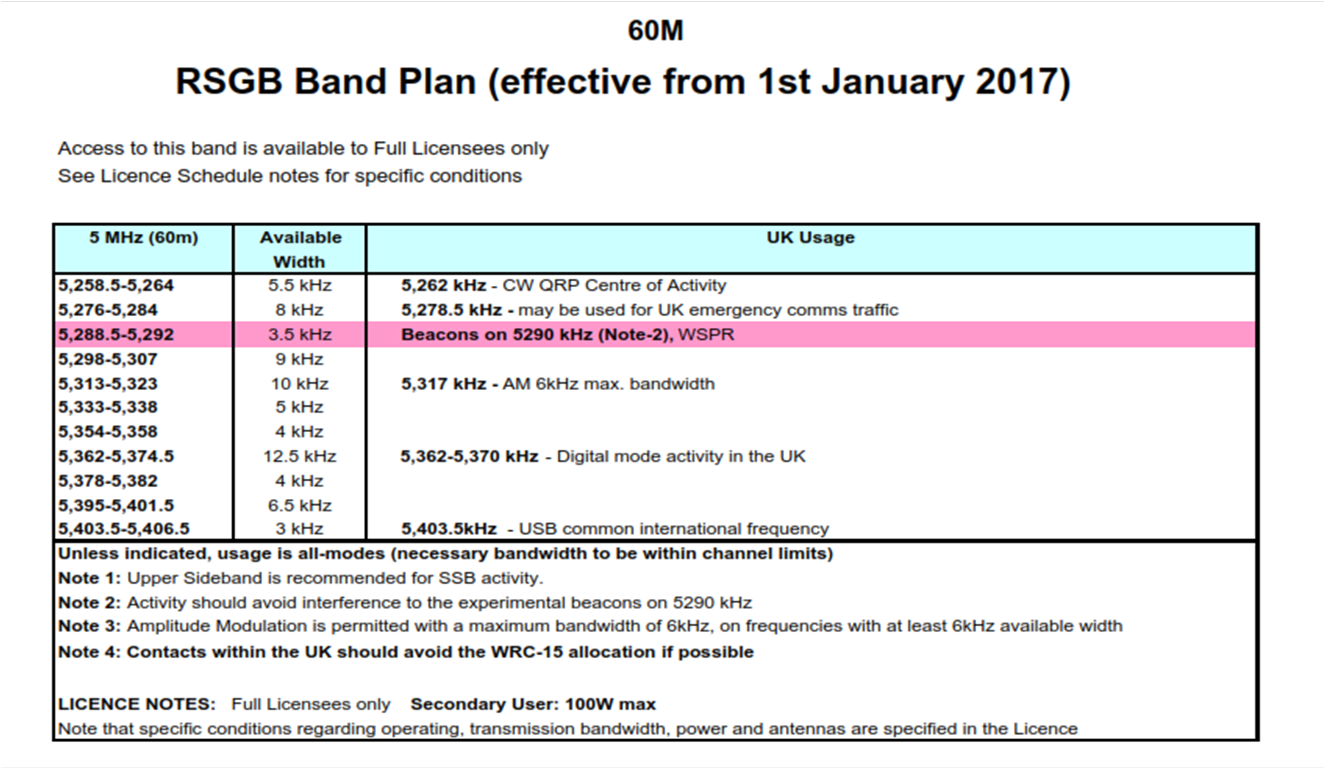
N.B. Since January 2017 note 4
of the UK 5MHz Band Plan states that
'Contacts within the UK should avoid the WRC-15 allocation if
possible'
This will impact upon current UK 5
MHz activity, specifically the existing Worked All Britain (WAB)
5 MHz net on 5.354 MHz, which is
within the WRC-15 allocation and is used extensively by amateurs
outside of the UK by nearby European Countries.
At WRC-15 in November 2015, the amateur service achieved a new
15kHz secondary allocation between
5351.5 – 5366.5kHz.
This is not yet in effect and UK stations must adhere to the
frequencies set out in the licence schedule.
Digital mode activity between
5.362 -
5.370 MHz refers to data modes and NOT Digital Voice (DV)
see chart extract below
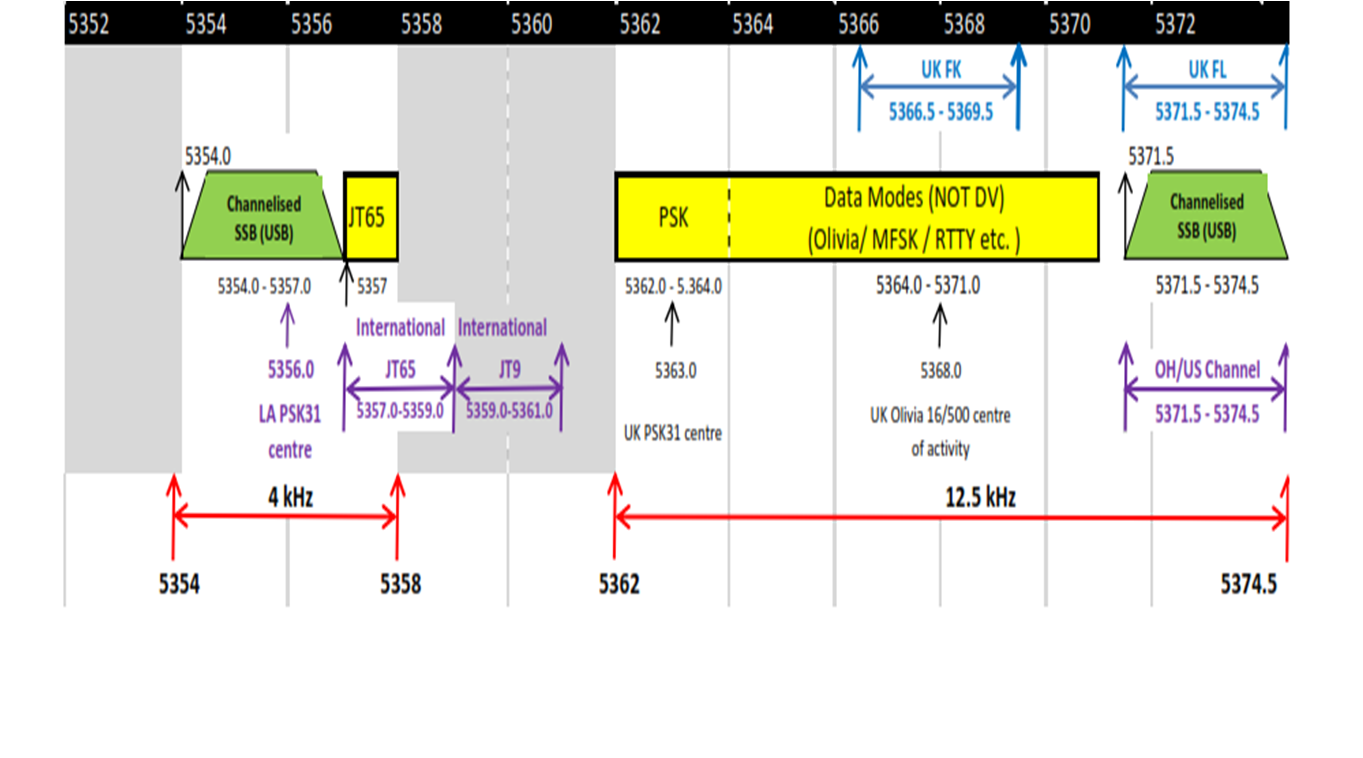
Specific user activity for various data
modes are currently found in the UK on and around the following
frequencies
5.357 MHz
- JT65
(USB dial
frequency 5.357 MHz plus
maximum +800 Hz AF, otherwise you will be transmitting outside UK
bandlet allocation, which stops at 5.358
MHz)
There have been numerous instances
of UK stations observed transmitting JT65/JT9 data modes above
5.358
MHz when
calling or working International stations who are
operating within their WRC-15 band allocation, to which we in
the UK do not yet have access.
5.363 MHz
- PSK31
(USB dial
frequency 5.362 MHz, plus +1000 Hz
AF)
5.368 MHz
- Olivia 16/500
(USB
dial frequency 5.3665 MHz, plus 1500 Hz
AF)
|
|
For an even better visualisation of the
new UK 5 MHz bandlets please see my 'activity heard' charts below.



For a higher
quality printable pdf version of these UK
5MHz band charts please click
on this link
Please note that
for USB operation in the UK bandlet segment between
5.354-5.358 MHz the frequency 5.354 MHz
USB should be used and NOT 5.355 MHz USB,
this is because this bandlet contains a tiny UK part of the Internationally
used 5.357-3.579 MHz JT65 digital data mode
segment, which would be interfered with if 5.354 MHz
was used by USB signals due to the bandwidth of that voice signal, no such
problem exists using 5.354 MHz USB.
As at December
2016 the Worked All Britain (WAB) 60 metre (5 MHz)
Net appears to be a regular user of 5.355 MHz
and may not be aware of the potential for them causing interference to other
UK and European Radio Amateurs trying to use JT65 data between
5.357-5.358 MHz.
|
|
5 MHz UK NoV conditions from 1st
January 2013
|
|
a) Antenna height must not be over 20m agl.
b) Maximum power: 100W (PEP) input into the antenna with the
expectation that this would not result in more than 200W EIRP.
c) Restrictions on message content have been relaxed and must now be
consistent with normal Terms and Conditions of the Full Amateur Licence.
d) Maximum Bandwidth: 6 kHz (double side band)
|
Within the UK on
5 MHz signal reports prior to 1st January 2013 did not use the conventional
amateur radio RST format, but used instead the SINPO table recommended by the ITU,
shown below.
| |
S |
I |
N |
P |
O |
|
Rating scale |
Signal
strength |
Interference |
Degrading effect of Noise |
Propagation disturbance |
Overall rating |
|
5 |
Excellent |
Nil |
Nil |
Nil |
Excellent |
|
4 |
Good |
Slight |
Slight |
Slight |
Good |
|
3 |
Fair |
Moderate |
Moderate |
Moderate |
Fair |
|
2 |
Poor |
Severe |
Severe |
Severe |
Poor |
|
1 |
Barely audible |
Extreme |
Extreme |
Extreme |
Unusable |
Too see the
latest maximum useable frequency for Inter-G working via NVIS look at the latest
Chilton Ionogram
http://www.wdc.rl.ac.uk/wdcc1/iono_menu.html and the fxI figure, in the
example below it is 7.10 MHz and is indicated by
the green coloured atmospheric reflections.
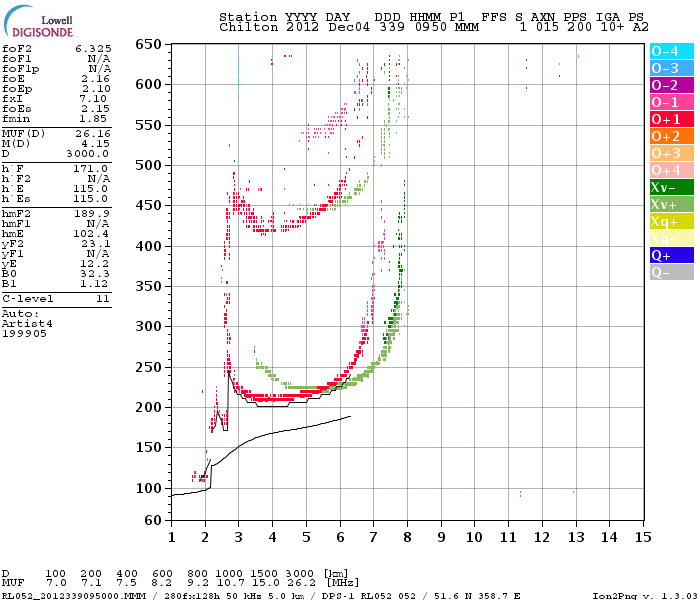
40m band (7 MHz)
This band is still under the influence of
the D-layer and is the lowest band showing an appreciable skip distance, up to
500 km at night. At noon it is hard to work stations located over 800 km away,
while working with the gray line or at night, this band is open to DX contacts.
This band is slightly influenced by 11-year solar cycle. Atmospheric noises are
still present, but not as strong as on the lower bands. QSOs can however be
difficult during summer months, but signals are not completely overridden by
static. This is also one of the most crowded bands and do not be surprised to
find in Europe and during weekends each station within 1 kHz or so from each
another. Recently in Region 1 this band was made
made accessible to amateurs from 7100 kHz up to 7200 kHz. Note that it is
already open to amateurs to 7300 kHz in North and South America.
|
7
MHz (40 metres) 7.000-7.200 MHz
|
|
Band plans
UK by RSGB |
7MHz
spots Cluster |
40m
antennas
|
Cobra Ultralight aerial
|
|
EMPTY
|
EMPTY
|
EMPTY
|
EMPTY
|
|
Frequency |
Mode
|
Remarks
|
|
7.000-7.040 MHz |
CW
|
Morse Code
|
|
7.040 MHz* |
USB (PSK31)
|
PSK31 activity (*since 29.03.09) |
|
7.040-7.047 MHz* |
All narrowband modes
|
All narrowband modes
(since 29.03.09)
|
|
7.047-7.050 MHz* |
All narrowband modes
|
*Unattended data stations (since
29.03.09) |
|
7.074 MHz |
USB (FT8)
|
FT8 Data
mode Activity
|
|
7.076-7.078 MHz* |
USB (JT65/JT9)
|
JT65/JT9 Data
mode Activity
|
|
7.050-7.200MHz |
All modes, LSB
|
Voice
|
|
7.070MHz |
LSB
|
Digital
Voice (DV)
|
|
7.080 MHz |
USB (PSK31) (Region 2
Americas)
|
PSK31 activity
(Region 2 Americas)
|
|
7.087.5 MHz |
LSB |
HFpack Net - Region 1 (Sunday 0730 UTC)
|
|
7.090 MHz |
LSB
|
QRP,
UK & World Scout
nets (0700 UTC daily Summer)
|
|
7.110 MHz |
LSB
|
Region 1 Emergency Centre of activity |
|
7.111 MHz |
LSB
|
 Proposed
Mobile /M (vehicle) calling/working frequency (When no Region 1 emergency
exists) Proposed
Mobile /M (vehicle) calling/working frequency (When no Region 1 emergency
exists) |
|
7.150 MHz |
LSB
|
RSGB News on Sundays
|
|
7.160 MHz |
LSB
|
Worked All Britain (WAB)
Net
|
|
7.163 MHz |
LSB
|
RAOTA Net
|
|
7.165 MHz |
LSB
|
Image centre of activity (SSTV etc.) |
|
7.185.5 MHz |
USB
|
HF Pack
Net, Portable, Manpack, Mobile |
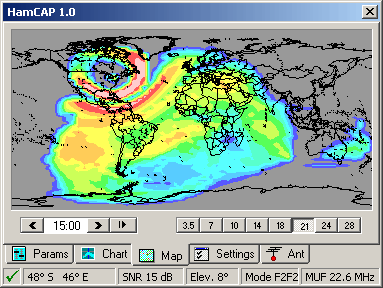
30m band (10 MHz)
Conditions are similar to the 40m band,
but this band works better in summer showing some of the properties of the 20m
band. As communications reach 1600 km at daytime and 12000 km or more at night,
this band is considered open for 24 hours a day. It is also the band least
affected by variations of the solar cycle. However this band is affected by the
ionization level of E and F-layers and at night, during the minimum of the solar
cycle, it is regularly above the MUF for most DX paths, becoming thus the higher
workable frequency for night time communications. With very few exceptions this
band is reserved for digital modes and CW.
N.B. Changes made June 2016 extending
down narrowband mode section by 10 kHz
20m band (14 MHz)
This is the primary HF band most used by Radio
Amateurs and open throughout the solar cycle in daylight hours. Indeed, the 20m band is the DX band par
excellence and is considered by many hams as the most reliable band for hunting
DX stations because atmospheric noises are weak.It is practically usable all the day long as soon
as there is propagation, and mainly in summer, and all the more during periods
of high solar activity. It is only during the minimum of the solar cycle that this band closes down in the late afternoon
and is unusable at night.The 20m band shows an appreciable skip distance
reaching about 700 km in daytime and exceeding 1600 km at night. It is
thus not suited to local QSOs.
|
14
MHz (20 metres) 14.000-14.350 MHz
|
|
Band plans
UK by RSGB |
14MHz
spots Cluster |
20m
antennas
|
EMPTY
|
|
EMPTY
|
EMPTY
|
EMPTY
|
EMPTY
|
|
Frequency |
Mode
|
Remarks
|
|
14.000-14.070 MHz |
CW
|
Morse Code
|
|
14.070 MHz |
USB (PSK31)
|
PSK31 activity
|
|
14.070-14.080 MHz |
USB (PSK31, PSK63, MFSK)
|
Narrowband modes
|
|
14.074 MHz |
USB (FT8)
|
FT8 Data
mode Activity
|
|
14.076-14.078 MHz |
USB (JT65/JT9)
|
JT65/JT9 Data
mode Activity
|
|
14.079 MHz |
USB (MFSK)
|
MFSK activity
|
|
14.080-14.089 MHz |
USB (RTTY)
|
RTTY
|
|
14.089-14.099 MHz |
USB (AX25 Packet)
|
Packet
Radio
|
|
14.099-14.101 MHz |
Reserved for Beacons
|
Beacons only
|
|
14.101-14.112 MHz |
USB (AX25 Packet)
|
Packet
Radio
|
|
14.112-14.350 MHz |
USB, AM
|
Voice
|
|
14.130 MHz |
USB
|
Digital Voice
|
|
14.178 MHz |
USB
|
'Audio Net' ESSB (Hi-FI
quality SSB speech)
 |
|
14.195 MHz |
USB
|
DXpedition calling
|
|
14.222 MHz |
USB
|
 Proposed
Mobile /M (vehicle) calling/working frequency Proposed
Mobile /M (vehicle) calling/working frequency |
|
14.230 MHz |
USB (SSTV)
|
SSTV centre of activity
|
|
14.260 MHz |
USB
|
IOTA activity
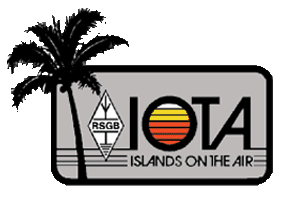 |
|
14.285 MHz |
USB
|
QRP
Centre of activity
|
|
14.286MHz |
AM
|
AM calling
|
|
14.290 MHz |
USB
|
UK & World Scout
nets (0700UTC daily Summer)
|
|
14.295 MHz |
USB
|
Goddard Space Shuttle rebroadcasts
|
|
14.300 MHz |
USB
|
Global Emergency Centre of activity |
|
14.342.5 MHz |
USB
|
HFpack Net Primary Portable, Manpack |
|
14.345 MHz |
USB
|
VHF Net
|
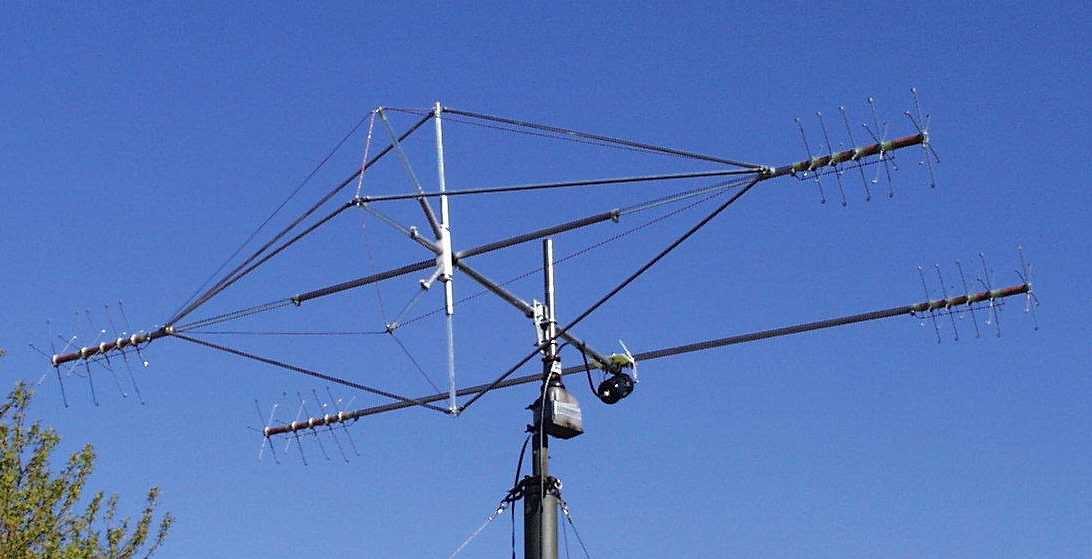
17m band (18 MHz)
This band is similar to the 15m band in
many respects although its activity is affected by the 11-year solar cycle, but
not as pronounced. During the maximum of the solar cycle this band is open
all day, up to well after sunset. When the solar cycle decreases this
band closes earlier, just after sunset. At the minimum of the solar cycle
this band opens to middle or equatorial latitudes, allowing north-south contacts,
but mainly around noon. This band is mainly open during daytime with the skip
distance reaching 1200 km in daytime and
disappearing at night.
15m band (21 MHz)
This band works similar to
the 17m band and is considered by most amateurs as a quieter alternative to the
20m band. It shows however a greater sensitivity to the fluctuations of the
solar cycle. It is mainly used in daytime but during the peaks of solar activity
DX contacts can extend to the night. During the minimum of the solar cycle this
band can be closed except for a few trans-equatorial paths. Like 12m and 10m
this band is also subject to weak Sporadic-E activity mainly in early summer and
mid-winter. The skip distance reaches 1300 km at daytime and disappears at
night.
|
21
MHz (15 metres) 21.000-21.450 MHz
|
|
Band plans
UK by RSGB |
21MHz
spots Cluster
|
15m
antennas
|
EMPTY
|
|
EMPTY
|
EMPTY
|
EMPTY
|
EMPTY
|
|
Frequency |
Mode
|
Remarks
|
|
21.000-21.070 MHz |
CW
|
Morse Code
|
|
21.070-21.099 MHz |
All narrowband modes
|
Narrowband data modes
|
|
21.070 MHz |
USB (PSK31 data) |
PSK31 data mode main activity |
|
21.076-21.078 MHz |
USB (JT65/JT9)
|
JT65/JT9 Data
mode Activity
|
|
21.110-21.120 MHz |
USB (Data)
|
Automatic unattended data modes |
|
21.120-21.149 MHz |
CW
|
Morse Code
|
|
21.149-21.151 MHz |
Reserved for beacons
|
Beacons only
|
|
21.151-21.450 MHz |
USB
|
All modes
|
|
21.180 MHz |
USB
|
Digital Voice
|
|
21.222 MHz |
USB
|
 Proposed
Mobile /M (vehicle) calling/working frequency Proposed
Mobile /M (vehicle) calling/working frequency |
|
21.260 MHz |
USB
|
IOTA
activity
|
|
21.285 MHz |
USB
|
Voice QRP
|
|
21.340 MHz |
USB (SSTV etc.)
|
Image centre of activity
|
|
21.360 MHz |
USB
|
Global emergency
|
|
21.400 MHz |
USB
|
Transatlantic Maritime Net (Daily 1300UTC)
|
|
21.425 MHz |
AM
|
AM activity
|
|
21.437.5 MHz |
USB
|
HFpack net, Portable, Manpack, Mobile
|
12m band (24 MHz)
This band varies depending on the solar
cycle and combines the best from the 15m and 10m bands. One year before
solar cycle maximum and up to one year after this peak, this band allows DX
contacts until after sunset with practically any kind of antenna. However, when
the solar cycle descends from maximum, this band is open at mid and low
latitudes only at daytime, with very few openings after sunset. Near the minimum
of the solar cycle this band becomes unusable, except at daytime for the highest
latitudes with some North-South openings. This band is open to Sporadic-E
traffic between the late spring and early winter. The skip distance reaches
1600
km at daytime and vanishes at night.
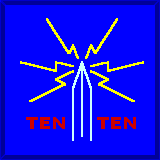
10m band (28 MHz)
This band works in the same way as the 12m
band, but is characterized by a great variability according to the solar cycle.
During the peaks of the solar cycle DX contacts can be established with very low
power and over 12000 km away. It is mainly a daytime band, but remains open a
few hours after sunset. During moderate solar activity this band opens near noon
for some trans-equatorial communications, but is closed for the higher
latitudes. During the minimum of the solar cycle this band is straight out dead.
There are however some exceptional openings for Ionoscatter, Meteor Scatter and
Sporadic-E. This occurs mainly between April and early August allowing multi-hop
communication up to 4100 km. This band is relatively quiet compared to the 15m
band, for example, but it works globally very well for DX communications. The skip distance reaches
2000 km at daytime.
|
28
MHz (10 metres) 28.000-29.700 MHz
|
|
Band plans
UK by RSGB |
28MHz
spots Cluster |
10M
Repeaters
|
10m
antennas
|
|
10-10
International |
6 and
10 Report
|
10 Metre Net
|
EMPTY
|
|
Frequency |
Mode
|
Remarks
|
|
28.000-28.070 MHz |
CW
|
Morse Code
|
|
28.070-28.120 MHz |
All narrowband modes
|
Data modes
|
|
28.076-28.078 MHz |
USB (JT65/JT9)
|
JT65/JT9 Data
mode Activity
|
|
28.120 MHz |
USB (PSK31)
|
PSK31 activity
|
|
28.120-28.150 |
Narrowband modes |
Automatically controlled data stations
(unattended) |
|
28.150-28.190 MHz |
Narrowband modes
|
|
|
28.190-28.225 MHz |
Reserved for Beacons
|
Beacons only
|
|
28.225-29.200 MHz |
All modes
|
|
|
28.327.5 MHz |
USB
|
HFpack Net, portable, manpack, mobile
|
|
28.360 MHz |
USB
|
Voice QRP
|
|
28.500 MHz |
USB
|
Voice calling frequency
|
|
28.555 MHz |
USB
|
 Proposed
Mobile /M (vehicle) calling/working frequency Proposed
Mobile /M (vehicle) calling/working frequency
|
|
28.680 MHz |
USB (SSTV)
|
SSTV centre of activity
|
|
28.885 MHz |
USB
|
Cross-Band 50 MHz (6M) working
|
|
29.100-29.200 MHz |
FMn
|
FM simplex (10kHz
channels)
(New since 2012) |
|
29.200-29.300 MHz |
All modes
|
FM most likely use
|
|
29.210 MHz |
FMn
|
UK Internet Gateway channel
|
|
29.290 MHz |
FMn
|
UK Internet Gateway channel
|
|
29.300-29.510 MHz |
Satellite downlinks
|
Satellite use only (AMSAT)
|
|
29.520 MHz RH1 |
FMn (Repeater inputs) |
Repeater input RH1
|
|
29.530 MHz RH2 |
FMn (Repeater inputs) |
Repeater input RH2
UK Internet Voice
Gateway channel |
|
29.540 MHz RH3 |
FMn (Repeater inputs) |
Repeater input RH3
|
|
29.550 MHz RH4 |
FMn (Repeater inputs) |
Repeater input RH4
|
|
29.560 MHz RH5 |
FMn (Repeater inputs)
|
Repeater input RH5
|
|
29.570 MHz RH6 |
FMn (Repeater inputs)
|
Repeater input RH6
|
|
29.580 MHz RH7 |
FMn (Repeater inputs)
|
Repeater input RH7
|
|
29.590 MHz RH8 |
FMn (Repeater inputs)
|
Repeater input RH8
|
|
29.600 MHz |
FMn
|
Region 1 FMn Simplex
CALLING channel
|
|
29.610 MHz |
FMn
|
Region 1 FMn Simplex Repeater (Parrot) |
|
29.620 MHz RH1 |
FMn
(Repeater outputs) |
Repeater output RH1
10 kHz FMn Repeater
outputs (-100 kHz shift) |
|
29.630 MHz RH2 |
FMn
(Repeater outputs) |
Repeater output RH2
UK Internet voice gateway |
|
29.640 MHz RH3 |
FMn
(Repeater outputs)
|
Repeater output RH3
10 kHz FMn Repeater
outputs (-100 kHz shift) |
|
29.650 MHz RH4 |
FMn
(Repeater outputs)
|
Repeater output RH4
10 kHz FMn Repeater
outputs (-100 kHz shift) |
|
29.660 MHz RH5 |
FMn
(Repeater outputs)
|
Repeater output RH5
10 kHz FMn Repeater
outputs (-100 kHz shift) |
|
29.670 MHz RH6 |
FMn
(Repeater outputs) |
Repeater output RH6
10 kHz FMn Repeater
outputs (-100 kHz shift)
|
|
29.680 MHz RH7 |
FMn
(Repeater outputs)
|
Repeater output RH7
10 kHz FMn Repeater
outputs (-100 kHz shift)
|
|
29.690 MHz RH8 |
FMn
(Repeater outputs)
|
Repeater output RH8
10 kHz FMn Repeater
outputs (-100 kHz shift)
|
|
|
|
|
In 2016, I had been giving some
more thought to the lack of proposed distinct HF mobile /M operating Net
frequencies in the main HF bands. A Google search for HF mobile Nets draws a
blank, so as a keen HF mobile operator (until 2023) I had been considering making some
proposals for frequencies that would work well in Region 1. Whilst you can of
course call on any permitted frequency often mobile operators want to
communicate with other /M operators or home based operators simply don't know
where to begin to look for /M activity. It can be both difficult and dangerous
to change frequency easily whilst driving, tuning in precise SSB signals
requires care so setting a designated and easily remembered 'channel' makes the
most sense for the driver. Factors for choosing some suggested frequencies
included avoiding other known regularly active Nets and having easy to remember
frequencies, so at first glance the use of 'Triples' seems appropriate.
|
HF
Mobile (/M) Operating Net Frequencies
|
|
3.666 |
7.111 |
14.222
|
21.222
|
|
28.555 |
|
|
|
|
Frequency |
Mode
|
Remarks
|
|
3.666 MHz |
LSB
|
Open locally all day, DX possible during darkness hours, but
antenna efficiency poor
|
|
7.111
MHz |
LSB
|
N.B. Close to Region 1 designated
Emergency centre of activity at 7.110 MHz, but 99% of the time should be
free
|
|
14.222 MHz |
USB |
Previously suggested by 'DL' amateurs and good band for
working throughout Europe
|
|
21.222 MHz |
USB
|
Better for DX working
|
|
28.555 MHz |
USB
|
Sporadic E skip in Summer should
allow for both local and extended European contacts |
|
|
|
|
|
|
|
|
Shown below is a screenshot using
PSK Reporter of stations heard
by me on 28.076 MHz (10m), using JT65 HF mode, on
Tuesday 18th October 2011.Amazing conditions considering we are only a little
way out of sunspot minimum and already DX is visible on 4 Continents all at the
same time.
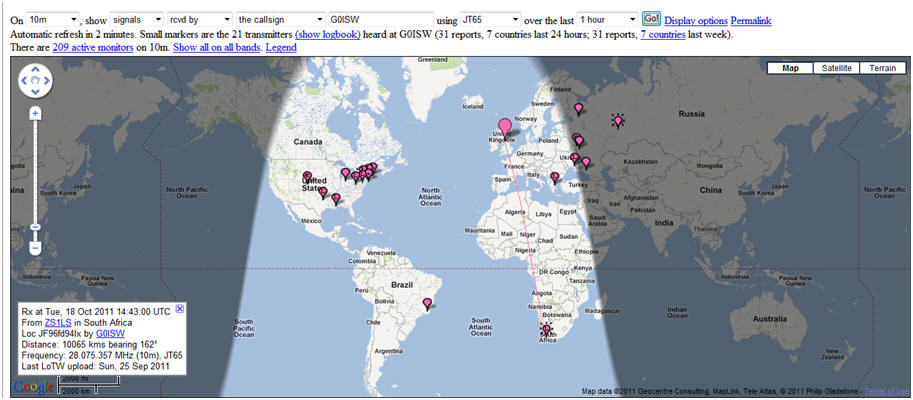
Here below is the
accompanying JT-65 HF software screen grab showing ZS1LS
in South Africa, PU3WSF in Brazil and several US
stations.
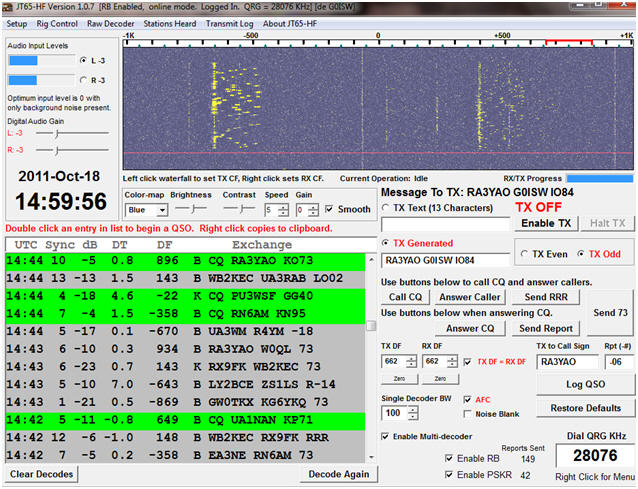
The holder of an Advanced (Full) UK licence
may allow an unlicensed person to send a greetings
message provided it is under the direct supervision of the licensee, or if a
club an
authorised club member, who must operate the transmitter and identify the
station.
Each greetings message must not be longer
than five minutes and each person may send only one message to each station with
which the station is in contact. Greetings messages
may be sent and received only within the UK, or to and from stations in the
United States of America, the Republic of Maldives, Gibraltar, Malta and
Falkland Islands.
Greetings messages may also be sent to or from stations in
Canada and Pitcairn Islands provided that each greetings message does not exceed
two minutes. When using a digital mode, anyone may type the message for
transmission.

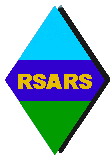

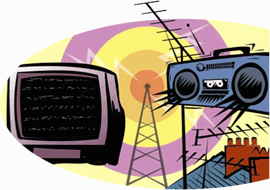
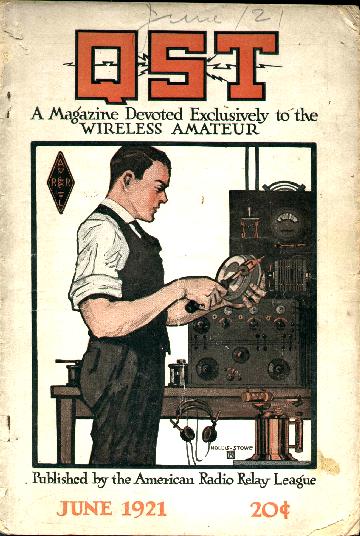

I became very interested in
experimentation with different microphones, and audio mixing, and regularly
listen to the US 'Audio Net' on 14.178 MHz each day, where superb SSB audio
could be heard. I was saddened to hear that
Bill W2ONV had become a silent
key in 2007, as he had the best audio I have ever heard on HF and was a true
gentleman always helping others. I had the pleasure of previously working Bill
on air from my car as EI/G0ISW/M and talking to him across the Atlantic, after
having listened to him many times before and since. He will be missed by those
Radio Amateurs who knew him.


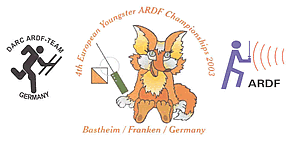
|
European
HF/50 MHz QRP Frequencies
|
|
Band name |
SSB VOICE
|
FT8 DATA |
CW |
|
80 Metres |
3.690 MHz LSB |
3.573 MHz USB |
3.560 MHz CW |
|
60 Metres |
5.3715 MHz USB
|
5.3565 MHz USB
|
5.262 MHz CW
|
|
40 Metres |
7.090 MHz LSB |
7.074 MHz USB |
7.040 MHz CW |
|
30 Metres |
No Voice |
10.136 MHz USB
|
10.106 MHz CW |
|
20 Metres |
14.285 MHz USB
|
14.074 MHz USB
|
14.060 MHz CW
|
|
17 Metres |
18.130 MHz USB
|
18.100 MHz USB
|
18.096 MHz CW
|
|
15 Metres |
21.285 MHz USB
|
21.074 MHz USB
|
21.060 MHz CW
|
|
12 Metres |
24.956 MHz USB
|
24.915 MHz USB
|
24.906 MHz CW
|
|
10 Metres |
28.360 MHz USB
|
28.074 MHz USB
|
28.060 MHz CW
|
|
6 Metres |
50.185 MHz USB
|
50.313 MHz USB
|
50.060 MHz CW
|
|
European
HF/50 MHz QRP Frequencies
|
|
Band name |
SSB VOICE
|
FT8 DATA |
CW |
|
80 Metres |
3.690 MHz LSB |
3.573 MHz USB |
3.560 MHz CW |
|
60 Metres |
5.3715 MHz USB
|
5.3565 MHz USB
|
5.262 MHz CW
|
|
40 Metres |
7.090 MHz LSB |
7.074 MHz USB |
7.040 MHz CW |
|
30 Metres |
No Voice |
10.136 MHz USB
|
10.106 MHz CW |
|
20 Metres |
14.285 MHz USB
|
14.074 MHz USB
|
14.060 MHz CW
|
|
17 Metres |
18.130 MHz USB
|
18.100 MHz USB
|
18.096 MHz CW
|
|
15 Metres |
21.285 MHz USB
|
21.074 MHz USB
|
21.060 MHz CW
|
|
12 Metres |
24.956 MHz USB
|
24.915 MHz USB
|
24.906 MHz CW
|
|
10 Metres |
28.360 MHz USB
|
28.074 MHz USB
|
28.060 MHz CW
|
|
6 Metres |
50.185 MHz USB
|
50.313 MHz USB
|
50.060 MHz CW
|


































